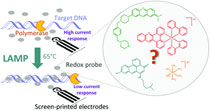Publication
799
Analyst, 141, 4196-4203, 2016
DOI:10.1039/C6AN00867D
|
|
|
|
|
|
 |
Real-time electrochemical LAMP: a rational comparative study of different DNA intercalating and non-intercalating redox probes |
|
|
|
Alexandra Martin, Laurent Bouffier, Kathryn B. Grant, Benoit Limoges, and Damien Marchal
Laboratoire d'Electrochimie Moléculaire, UMR 7591 CNRS, Université Paris Diderot, Sorbonne Paris Cité, 15 rue Jean-Antoine de Baïf, F-75205 Paris Cedex 13, France
Institut des Sciences Moléculaires, UMR 5255 CNRS, Université Bordeaux, 33400 Talence, France
Department of Chemistry, Georgia State University, Atlanta, USA
We present a comparative study of ten redox-active probes for use in real-time electrochemical loop-mediated isothermal amplification (LAMP). Our main objectives were to establish the criteria that need to be fulfilled for minimizing some of the current limitations of the technique and to provide future guidelines in the search for ideal redox reporters. To ensure a reliable comparative study, each redox probe was tested under similar conditions using the same LAMP reaction and the same entirely automatized custom-made real-time electrochemical device (designed for electrochemically monitoring in real-time and in parallel up to 48 LAMP samples). Electrochemical melt curve analyses were recorded immediately at the end of each LAMP reaction. Our results show that there are a number of intercalating and non-intercalating redox compounds suitable for real-time electrochemical LAMP and that the best candidates are those able to intercalate strongly into ds-DNA but not too much to avoid inhibition of the LAMP reaction. The strongest intercalating redox probes were finally shown to provide higher LAMP sensitivity, speed, greater signal amplitude, and cleaner-cut DNA melting curves than the non-intercalating molecules. |

